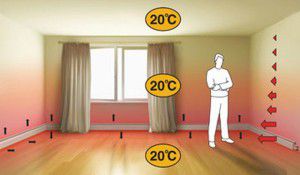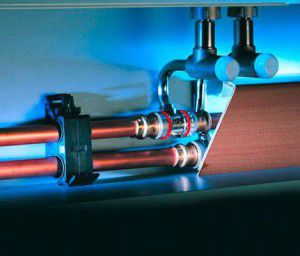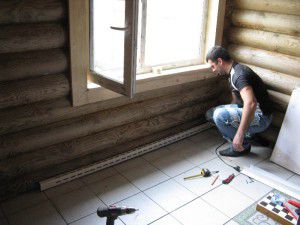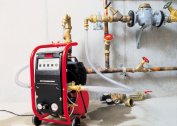To overcome the problem of uneven room heating, instead of traditional methods, a more progressive one is proposed - a plinth heating system. Now you do not need to install massive radiators under the windows, because they were replaced by warm skirtings, which are much easier to install. The skirting type heating system with a water or electric heat supply method is a sure step towards home comfort. Let's consider how plinth heating devices are arranged.
Baseboard heating principle
The baseboard heating system is based on a special way of installing its constituent elements - at the bottom of the wall. Thus, it is possible to more rationally distribute heat fluxes. Being installed around the entire perimeter of the room, plinth heating convectors transfer heat not so much to the surrounding air as directly to the walls, from which, in turn, the room air is also heated. Plinth heating radiators are recommended to be located mainly along the external walls, but they can also be installed along the internal partitions.
Heating devices are so compact that in their appearance they are almost indistinguishable from ordinary skirting boards. Inside each convector there are heat-exchange modules, which, depending on the type of system, are liquid or electric. The thermal conductivity of these heating devices is close to the maximum possible, since their structural elements are mostly made of copper and aluminum. It is enough to heat plinth heating radiators only to a temperature of 40–45 ° С.

Cases of devices are equipped with two rows of slots: cold air enters through the lower ones, and heated air exits through the upper ones. Plinth convectors for electric and liquid heating systems are installed close to the wall, and heat, as it were, flows from bottom to top along the wall surface. As a result, judging by the reviews, plinth heating provides a more uniform heating of the room, compared with conventional radiators.
Two different concepts should not be confused: baseboards for heating pipes and baseboards for water heating. The first of them means one of the ways of supplying the coolant (bottom) to a conventional radiator, and the second is a special type of heating system.
First, let's pay attention to the peculiarities of plinth piping in traditional water heating systems.
Plinth layout of heating pipes
It is possible to lay pipelines from a water heating boiler to radiators in different ways: from above or from below, open along the wall or by hiding in gates. Alternatively, you can mount the heating pipes in a special box attached to the bottom of the wall. This half-hidden installation method is called skirting the heating system. To speed up installation work, manufacturers recommend purchasing ready-made sets of baseboards.
For example, the baseboard system for installing Simplex heating pipelines consists of a set of all necessary elements, which includes straight parts and angles, joints and plugs. The outer, facing part of the box is an analogue of an ordinary plastic baseboard, the color of which can be chosen. The material used for this is resistant to constant exposure to high temperature.
The basic part of the structure is attached to the wall with several dowels. Installation of single-pipe and two-pipe skirting options for heating pipes is carried out using adjustable holders. Pipes with a diameter up to 22 mm are allowed. The design reliably holds the pipeline elements in a fixed position, and a removable decorative panel, if necessary, provides access for monitoring and maintenance.
The range of the supplier of baseboard systems for installation of heating piping simplex includes wiring elements compatible with hard or soft types of floor coverings. Boxes are also offered with the possibility of additional laying of low-current lines. The joints of radiators with the plinth distribution of the heating system can be closed with decorative panels of a special shape.
Now we will take an interest in the device of a plinth heating system: what varieties it is presented and what is characterized by.
Advantages and disadvantages of baseboard heating
The main advantage of plinth heating convectors is their compactness. These heaters have a height of no more than 15 cm from the floor with a thickness of only 3 cm.
Other benefits should be listed:
- uniform heating of the room over its entire area and stable air temperature both near the floor and under the ceiling;
- reliable protection of walls from dampness and, as a consequence, from fungus and mold, which is especially important for the construction of a wooden house;
- 22% reduction in fuel consumption due to the fact that there is no need to pay for “excess” heat;
- less laborious installation of baseboards and the availability of repairs;
- modern design, suitable for any style of interior.
Studying reviews of baseboard heating, one can not help but notice that this system also has disadvantages:
- the high cost of purchased equipment and payment for installation work;
- the need to use a circulation pump in the system;
- difficulties in balancing the system according to the degree of heating of each of the convectors;
- requirement that skirting radiators not be obstructed by furniture.
So that heat transfer does not decrease, you need to make sure that the convectors located near the floor are not clogged with dust.
Installing a system of warm skirting boards
When installing baseboard heating equipment, it must be borne in mind that the liquid and electric varieties of this system have fundamental differences.
Liquid (water) heating
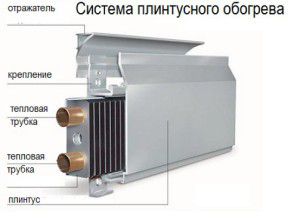
Basically, the baseboard convector for liquid heating systems consists of a heat exchanger and an external casing. In order to increase the heat transfer area, the copper-aluminum heat exchanger is equipped with numerous transverse plates.
The list of necessary devices for an autonomous system of plinth water heating includes such elements:
- boiler equipment using any type of fuel;
- coolant, most often water or non-freezing liquids;
- circulation pump, providing forced movement of the coolant;
- collectors for supply and return circuits;
- pipelines for wiring plinth heating systems copper, metal-plastic or PVC;
- skirting radiators for heat transfer in rooms;
- thermostats, manometers.
The connection of the skirting type liquid heating system circuits to the collector is carried out according to the beam pattern. Such a scheme is preferable when it is necessary to heat a large number of rooms on several floors. So it is possible to ensure the efficiency of skirting equipment and reduce heat loss.
To mount a system of warm water skirting boards, you must:
- lay two tubes along the walls in areas from the collector to the installation site of each of the radiators;
- in the selected place at the junction of the wall and the floor, install the back panel of the baseboard convector for the liquid heating system with fasteners;
- connect the supply and return pipelines to the heat exchanger;
- hang the mounted radiator on the mounting hooks of the rear panel;
- check the tightness of the connections;
- install an external decorative panel;
- proceed with pressure testing and balancing the baseboard heating system.
The coolant is poured into the system, while at the same time blowing air out of it using specially designed devices. After complete filling and trial run of the system, determine the areas where there is still air, and also remove it.
In order for plastic pipes to last longer in the baseboard heating system, the coolant should not be heated above 85 ° C, and the pressure should not exceed 3 atm.
Electric baseboard heating
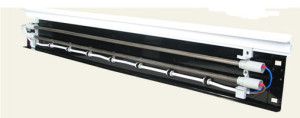
An electric-type plinth heating system is much easier to install than a water-based one, because there is no need to lay pipelines that supply the coolant to the radiator. In this case, the main element of the heating device is a radiator unit with an electric heater. The heater is built into a copper tube in the lower part of the radiator, and an electric cable covered with heat-resistant insulation passes through the upper tube.
They feed on plinth electric heating convectors from a regular home electrical network. In this case, the wiring must be able to withstand increased loads, because the calculated power consumption will be at least 200 watts per meter of the heating system.
It is more convenient to lay a power cable for baseboard heating even at the construction stage of a house. They make exits at the connection points for convectors and temperature sensors for electric baseboard heating, then fill the floors and plaster the walls. Elements of a warm skirting board are installed after completion of all finishing work. Heating devices are mounted along the walls, connected to power supply and regulate thermostats.
Despite the high degree of moisture protection, it is undesirable to install electric skirting radiators in a bathhouse and other rooms with high humidity.
Placing heating elements on the bottom of the walls is becoming one of the most efficient heating methods. In most rooms where we spend considerable time - in a cottage, apartment or office - baseboard heating helps to create a surprisingly pleasant microclimate.
A video presentation will help to realize the convenience of creating an electric baseboard heating system in a house:
